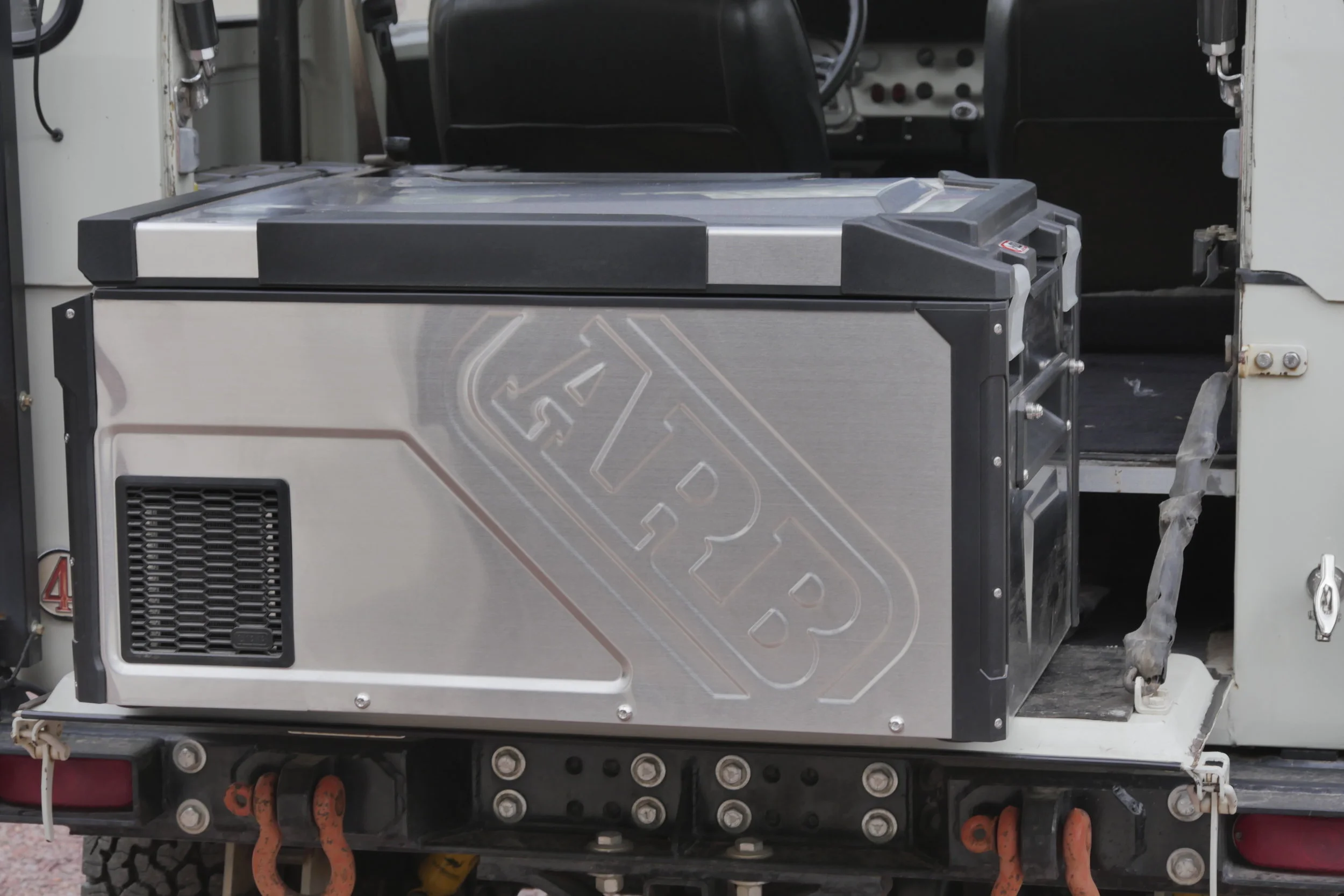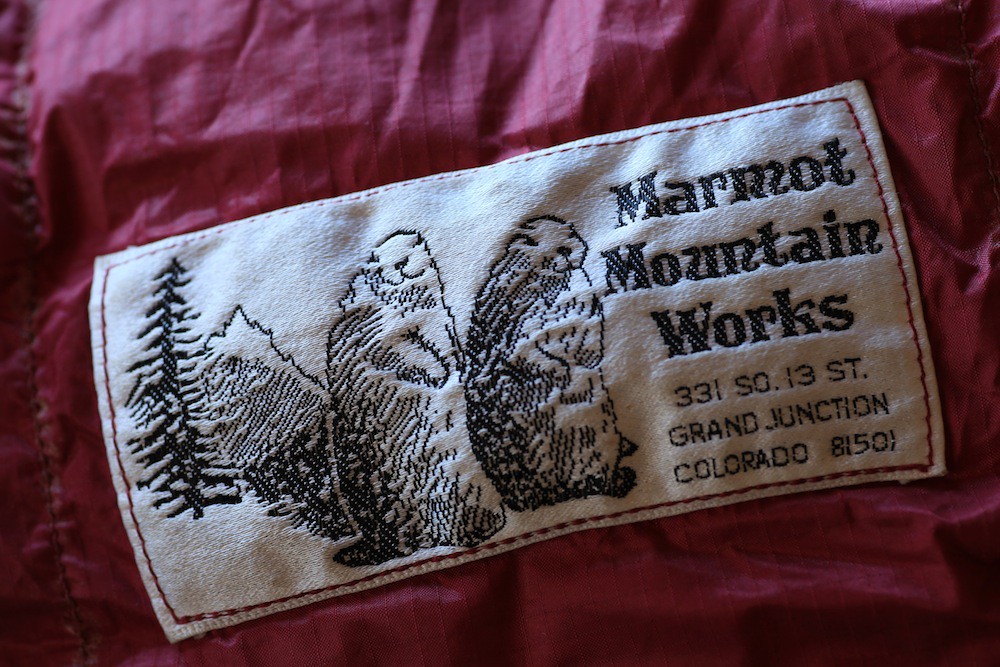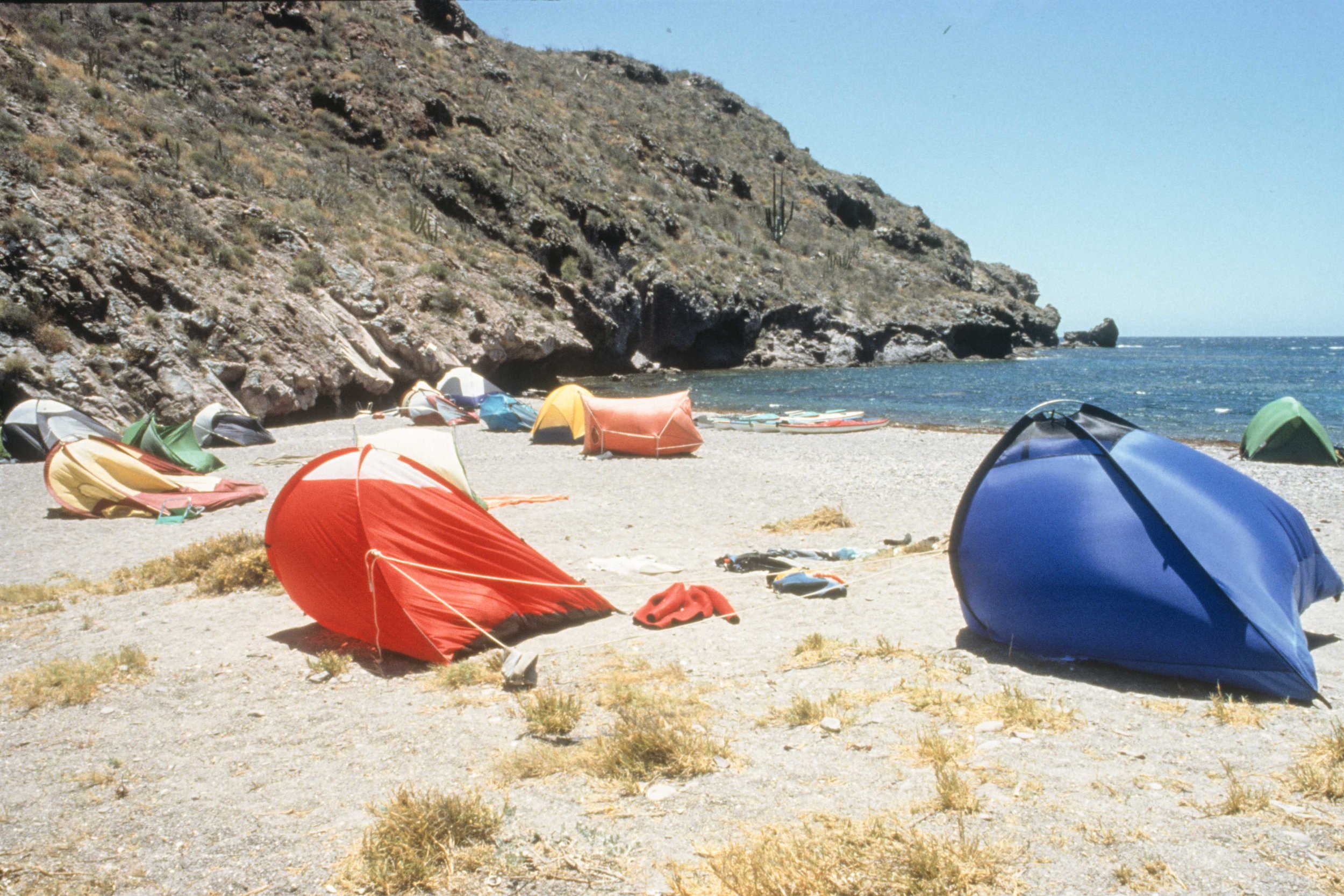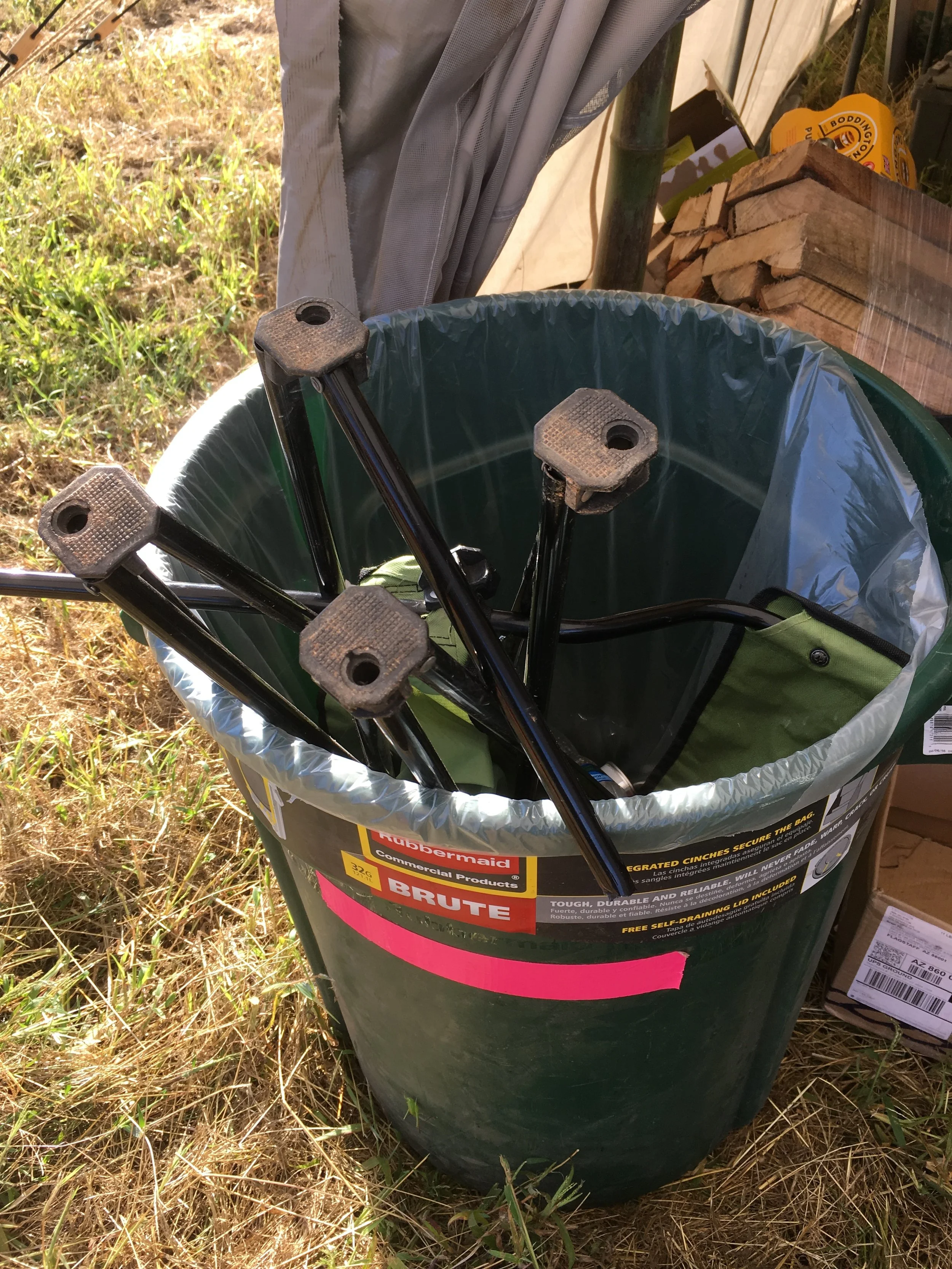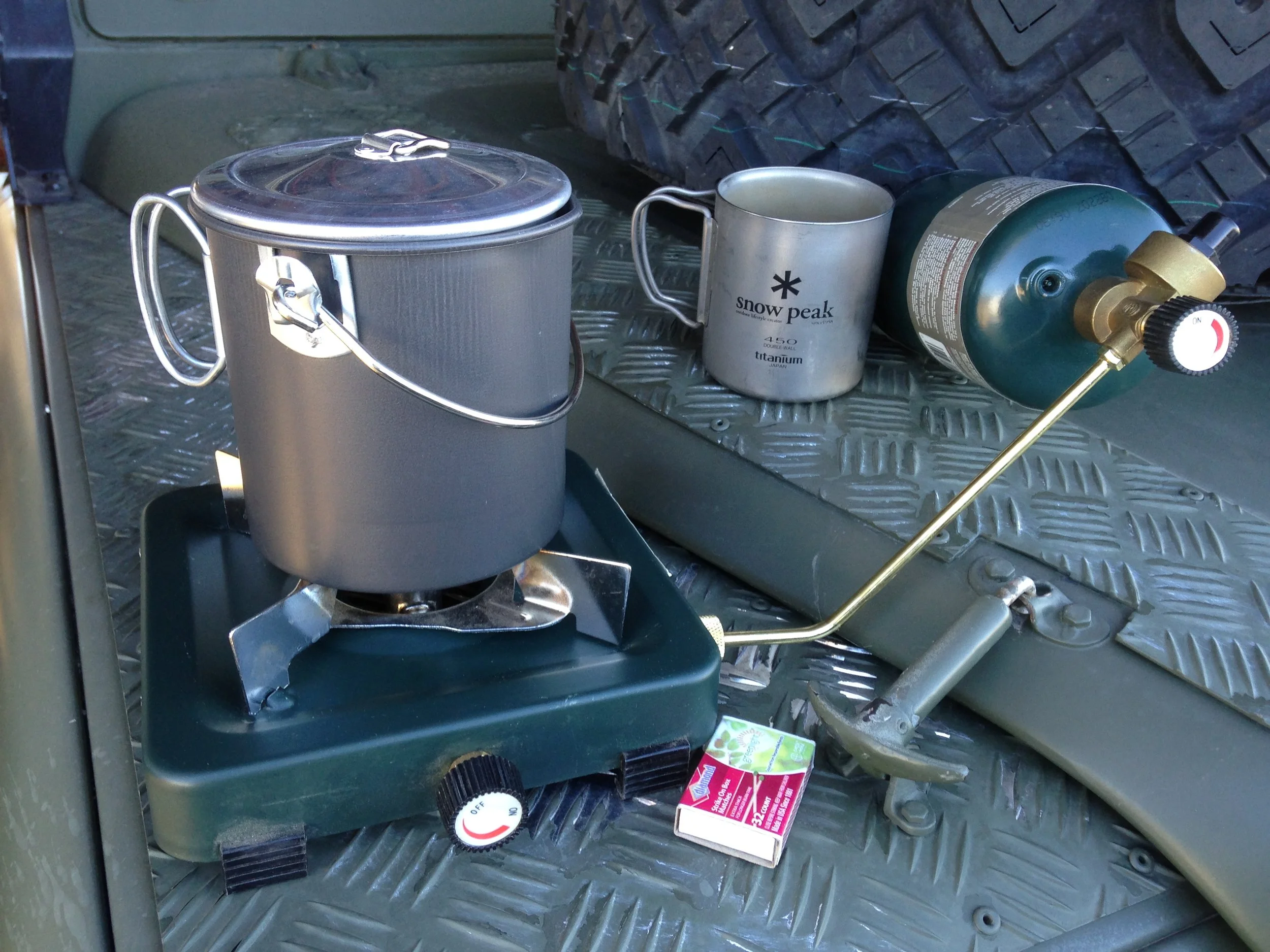
Overland Tech and Travel
Advice from the world's
most experienced overlanders
tests, reviews, opinion, and more
A different Dormobile
Most people reading this are familiar with the iconic Land Rover Dormobile and its clamshell pop-up roof, which converts a long-wheelbase Series II into a stylish camper with full standing headroom. But I didn’t realize that Dormobile modified other vehicles as well, such as this 1961 Bedford CA van. Very practical if you didn’t need the four-wheel-drive of a Land Rover. Read more about it on Silodrome, here.
The new ARB Elements fridge/freezer
The call came from our commercial mail service. “Hi Jonathan. You have a really big box here, and it’s heavy!” I knew it could only be one thing: the new ARB Elements fridge I’d been assigned to review for OutdoorX4 magazine.
Even back home and excised from its substantial packing, the Elements fridge is an impressive piece of equipment at 70 pounds, 32 inches long, 19 inches wide, and 17 high. It’s strikingly handsome as well in its cladding of 304 stainless steel and black trim. You might or might not go for the huge embossed ARB logo on each side, but the formed panel increases rigidity so it’s not purely cosmetic.
More important is the substantial redesign—a complete re-envisioning, actually—that ARB undertook three years ago when conceptual work reportedly started on this fridge. In an increasingly crowded and sophisticated market, a simple tweaking of the previous model, introduced in 2008, wasn’t going to cut it. So the Elements (available for now only in a large 60-liter version) incorporates a bunch of innovative features.
First, as the name implies, is the weatherproofing. You can leave this fridge strapped down in the bed of your pickup all year (preferably using the available tamperproof bolts). Precipitation won’t hurt it, and the black ASA (acrylic-styrene-acrylonitrile) trim is similar in strength to ABS resin but significantly more resistant to UV degradation. The hinges are stainless-steel castings; the twin aluminum latches are a huge improvement over the previous generation’s single plastic catch, which always felt fragile. (However, one disadvantage compared to the old fridge is that there is no easy way to quickly strap this one down without purchasing the optional tie-down kit or mounting base. The carry handles are comfortable but provide no way to loop anything over them.)
The three icon buttons lower left control the electronic combination lock
There’s a slot to secure a padlock, but a far more stylish way to prevent your friends pilfering your Samuel Smith’s ale is the electronic lock incorporated into the (weatherproof) control panel. Program in your own code using the three icon buttons, or leave it disabled as you wish. With the lid locked closed, the recessed temperature buttons cannot be accessed, so your stymied and jealous friends can’t secretly warm up the beer. The lock projects a pin into a fitting in the lid, and would clearly not withstand a crowbar, so if serious antitheft capability is needed (i.e. steaks, lobster, Veuve Clicquot, etc.) I’d default to a shackled lock.
Open the lid and the first thing you’ll notice is the clever single hydraulic strut, which magically holds the lid open at any position you wish. An LED lights up the all-white interior, which is massive if you’re used to the standard 40-liter-size fridge. There’s a big bottom compartment and a high shelf, which can be blocked off as a produce shelf by turning the basket around so its high side is toward the shelf. Turned the other way, the basket allows long items to be laid horizontally. One feature that might be an issue for some vehicles: There is no way to convert the lid to side-opening.
Mechanically, the Elements uses an industry-standard Nidec/Secop (formerly Danfoss) BD35F compressor, with a three-stage low-voltage cutoff. Of the two standard 12V fridge compressors—this and the Sawafuji swing-motor compressor—the Secop tends to run more quietly at the expense of a more complex mechanism. The Secop can also be run at different speeds to optimize power use. Both compressors have proven reliable over the years, and both will operate at significant angles, unlike the cheap absorption-type fridges still found in some RVs and campers. ARB enhanced the performance and efficiency of the Elements by incorporating a full-height evaporator; this should keep temperatures more uniform throughout the fridge. Those temperatures can be dialed down to 0º Fahrenheit (-18ºC) if you choose, even in 90º (35ºC) weather. The walls on the Elements are noticeably thicker than those on my old ARB fridge, which will also help keep power consumption down.
Options for the Elements include a remote temperature monitor, various bases, and a tie-down kit. If you buy the latter, a word of caution: The slots on the metal buckles of mine were razor sharp and would have severed a strap in short order; I had to file them smooth.
I was a bit surprised that ARB’s initial release of the Elements was in the larger, 60-liter model rather than the more common 40-45-liter size, but perhaps the decision was driven by their own sales figures of the previous version. I’m certain other sizes will follow, and I’m curious if the company will eventually add a model with separate fridge and freezer compartments.
Overall, I think ARB has built a fridge that is several genuine steps forward and will carry on the sterling reputation of the company.
Measure first! The Elements barely fit in the back of my FJ40
ARB USA is here. Retail on the Elements fridge, for some strange reason known only to the marketing department, is $1444.49
So, you think your Zarges cases are stylish?
How about an aluminum-clad explorer’s trunk from Louis Vuitton?
Apparently only a few of these trunks were produced in 1892, and of that few only two known examples survive. This one was recently auctioned by Christie’s for the astounding figure of £160,000 ($206,000). For that price you could buy 412 similarly sized Zarges cases.
But they wouldn’t say Luis Vuitton on the label.
Apparently this one spent much of its life in the UK basement of a family who had no idea of its value.
More here.
Quality camping gear: when (and when not) to economize
A recent Facebook dialogue regarding the post “OCTK Lite part 2,” and its comparison of quality in outwardly similar tools, reminded me of a column I published in OutdoorX4 some time ago regarding equipment quality in general. I thought it was worth revisiting. Herewith:
I’ve been reviewing outdoor equipment for 30 years now, and using it for a lot longer, in conditions ranging from 115ºF Sonoran Desert summers to Beaufort Sea storms. In a few situations I’ve felt the sharp realization that my life was quite possibly hanging on the quality of my equipment—lost in a winter storm skiing the North Rim of the Grand Canyon, caught seven miles offshore in a sea kayak in a Sea of Cortez chubasco—but in the overwhelming majority of circumstances it’s only been comfort, or the lack thereof, that has been affected by the gear I was using.
Nevertheless, in that time I’ve become convinced of the near-universal truth of this axiom: The best gear is also the least expensive in the long run. Spend more in the beginning on a quality piece of gear, and it will not only perform better, enhancing your comfort (and potentially your safety), it will also last longer, justifying its price over and over. Just one example is the Marmot Gore-Tex Grouse goose-down sleeping bag I bought in 1983. Scandalously expensive at the time on a penurious college-student budget, it has since seen untold nights of use, and has lost, as best I can estimate, perhaps a half inch of loft. I could go on with many other examples.
Okay, as I’ve been adminished many times, that’s fine in theory. But what if one simply does not have, say, $500 to spend on a sleeping bag, and $200 on a stove, and $50 on a double-wall titanium coffee cup? Am I suggesting that person stay home and leave travel to those who can afford bespoke equipment?
Not at all. My overriding goal in being in this business is to encourage people to get out exploring. One can only truly appreciate something if it is experienced in person, and if we are to preserve the most beautiful parts of our country and the world, we need people there seeing those parts and developing a bond of stewardship. And traveling and experiencing other cultures is the best way to stave off the xenophobia and isolationism that seems to be gripping our country these days.
Thus when I offer equipment advice to those just starting out, or looking at replacing worn out gear, and who are on a budget, I emphasize a strategy of priority. There are areas where economizing can be done without much compromise in comfort (or safety), and others where compromising would be foolish. Here are my ideas of where you should and shouldn’t economize.
Tent: This is the big one. While traveling and camping your tent is your home—your last line of defense against rain, snow, wind, and bugs. You can survive with a cheap sleeping bag, but if your $39.95 dome tent leaks in a shower, or collapses in a breeze, the best sleeping bag in the world won’t keep you comfortable—or safe. Whether you’re after a lightweight backpacking tent for motorcycle or bicycle travel, or a room-sized, stand-up model to carry in a vehicle, buy the best tent you can afford, and care for it well. (For an in-depth look at how to choose a good lightweight tent, see here.)
This Hilleberg is a good tent.
These are not good tents.
Sleeping bag: I own an exquisite, U.S.-made Western Mountaineering Sycamore MF sleeping bag stuffed with superb 850-plus fill-power goose down. It’s spacious, has a waterproof shell, is rated to 25ºF, and weighs barely two pounds. It cost $460, and I fully expect it to last the rest of my life. Yet, quite frankly, the $55 synthetic-fill Blue Jay bag from Wenzel, rated to the same temperature, would be just as warm, and cozier given the flannel lining. No, it won’t last as long, and it weighs over five pounds, which would be an issue if you’re motorcycling or pedaling, but for tossing in the back of the Tacoma, it’ll work just fine.
Sleeping pad: Yes, that $130 Thermarest LuxuryMap inflatable mattress is a dream to sleep on. But for about $70 you can buy a queen-size three-inch-think memory foam pad on eBay and cut two 30-inch wide sleeping pads from it.
Stove: Connoisseurs of outdoor cooking swear by the dual-burner Partner Steel stoves, made to survive professional river guide abuse and stout enough to be employed secondarily as a tire ramp for working under your vehicle. But in my FJ40 I keep a single-burner Stansport propane stove that cost me $12.50 ten years ago and is still going strong.
Camp chair: No matter how active you are, you’ll spend a lot of time in camp sitting. Do yourself a favor and skip the $20 specials with 30 plastic joints on them. I’ve lost count of the broken ones I’ve encountered—cleaning up after each Overland Expo we always find a half-dozen of them in dumpsters, a criminal waste of the planet’s resources. Look at the brilliant (and handsome), made in the U.S. Kermit Chair, which can be carried on a motorcycle or transformed into a full-size chair, the fine GCI Pico, or the bulkier but sturdy Picnic Time Sport Chair with its built-in cocktail table.
Coffee mug: Motorcycling or bicycling? Go for that Snow Peak titanium model. Driving a truck? If you spent more than $10 you’re just showing off.
Stove: $12.50. Mug: $45
Thermarest ProLite Plus
I remember the revelation of sleeping on my first Thermarest, in the early 1980s. For years I’d used various air mattresses, which were compact to carry, comfortable (if a bit bouncy), but prone to punctures (think southern Arizona backpacking . . .) and not good in cold weather; and foam pads, which were comfortable, puncture-proof, and well-insulated but, if thick enough, bulky and rather heavy. The marriage of the two was a stroke of genius, and I haven’t looked back since for backpacking, sea kayaking, and even, with the addition of the hedonistic base camp models, vehicle-oriented camping. Yes, there was still the odd puncture to deal with, but otherwise the Thermarest is indisputably the best of both technologies.
Cascade Designs has not by any means rested on the laurels of those first Thermarests. Especially with regard to the trekking models, they continually search for ways to reduce weight and storage bulk while retaining cushioning and insulation. So for a recent bicycle trip I decided to upgrade my 20-year-old, 3/4-length rectangular Thermarest to the current ProLite Plus. And was I glad I did.
The ProLite Plus, despite being a full-length model, is a bit lighter than my old one (1.6 pounds), and a bit thicker as well. Part of this savings came from the logical step of rounding off the ends of the original rectangular mattress, and tapering it to match the natural contours of the human body. More savings came from modern shell materials and diagonally die-cut foam. It stuffs to the same size as my old 3/4-length model, yet I was perfectly, even dreamily comfortable on it laid out over Negev Desert pebbles. Although I tend to roll around somewhat at night, I never had an issue with the width, and it was lovely to have cushioning under my legs and feet. I stayed warm on several nights that touched freezing—yet the rolled and stuffed mattress took up little precious space in my panniers.
A good night’s sleep is all the more critical when you’re expending a lot of energy during the day, and perhaps have a few muscles that are a bit stiff and protesting their recent treatment. The ProLite Plus contributed hugely to a rejuvenating slumber.
The ProLite Plus fit perfectly (and, here, invisibly!) under my semi-rectangular Western Mountaineering sleeping bag
They may not be perfect, but . . .
I admit to being a tiny bit anxious as the “official” resident Toyota Land Cruiser disciple when Graham Jackson and his wife, Connie Rodman, bought a 1994 Troopy to match the ’93 Roseann and I had bought, for a trip across Australia’s Simpson Desert and further explorations Down Under. You see, Graham has lived and breathed Land Rovers since his childhood in southern Africa when the family toured the Kalahari Desert in an early Range Rover. Connie is not far off in terms of disciple-hood, and the two of them drove a Defender 110 from London to Cape Town. While Graham has no intellectual prejudice against the Toyota, it’s clear where his heart lies.
So I naturally wanted those two Troopies to perform perfectly. Statistically I knew the odds were high, but we were dealing, after all, with two unfamiliar 20-plus-year-old vehicles with 230,000 km (ours) and 400,000-some km on the clocks. And Land Cruisers in Australia tend to be used as God and Toyoda-san intended.
And perform perfectly they did. The naturally aspirated 1HZ diesels earned praise from Graham for their 20-21 mpg economy at 110kph on Australia’s paved highways, and for their effortless low-end torque once we hit the Madigan Line to cross the desert. I believe I overheard an adjective along the lines of “fantastic” a few days into the trip.
Once out of the desert and past Birdsville, we cranked up the speed again to get back to Sydney. On one stretch of highway I switched from the near-empty front fuel tank to the full rear—and about 15 minutes later the engine started faltering.
Well. Dammit.
We pulled over and consulted. The consensus was that the transfer pump in the rear tank, which simply moves fuel to the front tank from where the main fuel pump picks it up, was failing to deliver an adequate supply to keep up with the consumption at high speed. Clogged fuel filters were ruled out as the engine-compartment-mounted factory units had been replaced before the trip. It was a minor issue as we didn’t need the range of both tanks on the highway; we dumped our spare jerry can of diesel into the front tank and continued with no further problems.But was that the glimmer of a smirk on Graham’s face as he drove off? Just a minute upturn at the corners of his mouth? So, they are not perfect.
Back in Sydney we left the vehicles with Daniel at the Expedition Centre for further modifications and an investigation into the fuel-delivery problem. And presently the answer came back.
At some point in the past 23 years a previous owner had, quite sensibly, installed a cheap Pep Boys plastic prefilter in the line just ahead of the rear tank—and then forgot all about it. Daniel’s mechanic found it, cut it open, and revealed a solid mass of gunk inside. Problem solved and truck running happily on either tank. They may not be perfect, but at least this issue was definitely not a Toyota issue.
To be fair, there was one other complaint acknowledged by us all regarding both vehicles: The stock seats were rubbish, especially after a couple of decades of ample Aussie bums bouncing around on them across the Outback. We’re addressing that now; report soon.
Irreducible perfection: Sea to Summit cargo straps
I have a confession that will seem like sacrilege to some outdoor enthusiasts: I’m not fond of Fastex buckles.
Why sacrilege? If you’re old enough to remember what we had before them, you’ll understand. The common fasteners for backpack straps, cargo straps, etc., were metal buckles with a sliding toothed bar to grip the strap. They were fussy and time-consuming, and eventually rusted. By contrast, the Fastex buckle (or, generically, side-release buckle) seemed like a miracle of convenience when it was introduced.
But they’re not perfect. They’re plastic and they do break—I’ve lost count of the one-tined buckles I’ve tossed over the years, and the habit of many equipment makers to permanently sew in the buckle doesn’t help. They’re also susceptible to UV degradation: I had a sea kayak that employed them to secure the cargo hatches and every six months I had to replace them all prophylactically to ensure they didn’t start failing in sequence on a rough crossing. Constant sun exposure quickly turned them powdery and brittle.
Finally, and importantly, injection-molded buckles lack any formal kind of working load limit parameters. One is never sure just how much stress a buckle of a certain size will accept before failing—and in some applications that can be critical.
All this was on my mind when I was shopping for cargo straps to secure my (very expensive) Hilleberg tent to the rear platform rack on my bicycle for a trip through Israel. By chance I discovered the Sea to Summit 10mm accessory straps. They employ a one-piece anodised aluminum toothed buckle impervious to UV degradation, and a relatively narrow (yes, 10mm) strap. Yet, lo and behold, on the buckle was a small tag listing a working load limit (WLL) of 125 kg. That’s 275 pounds to you non-metric people—more than enough, I figured, to safely secure a 4.5-pound tent.
In use over several hundred miles, the Sea to Summit straps performed perfectly. While not quite as fast as a plastic buckle would have been for securing and releasing, it still took seconds per strap. And despite securing a load that varied from just the tent to a tent plus jacket plus two-litre plastic water bottle, the straps never loosened one millimeter. I soon stopped checking every few minutes to make sure that expensive Hilleberg was still with me.
If you really want a quick-release function, Sea to summit sells the same strap with a hook release, but I wouldn’t bother. The foolproof security of the standard buckle is worth the extra few seconds of setup time. Need more strength? There’s a 20mm version as well, with a 330-pound WLL. Each width comes in three lengths, from 40 to 80 inches—enough to secure very bulky items.
Highly recommended. You’ll find dozens of uses.
The straps are here on Sea to Summit’s site.
A proper shovel
While equipping our Land Cruisers for a trip across the Simpson Desert, we picked up a cheap shovel at a military-surplus-cum-Chinese-camping-gear store in Sydney. Just how cheap became apparent the first night we tried to dig a fire pit. The shovel literally bounced off the ground—the blade simply bent and sprang back under any force at all. It was so bad all we could do was laugh.
That won’t happen with this one.
We needed indestructible shovels for the Camel Trophy Skills Area at the Overland Expo, and a short web search convinced me that those from Wolverine Hand Tools fit the bill perfectly.
If you name a shovel “Wolverine” it had better be tough, since its namesake is known for chasing grizzly bears off their kills to have a snack. Indeed, this one (DH15DP) is solid, welded steel except for a rubber foot brace (which can be changed side to side). The blade has a sharp wedge tip and most definitely will not bounce off the ground. The 26-inch shaft is steel, and welded to the blade around the perimeter of the joint on both sides. It’s not the prettiest weld on earth—there’s spatter under the paint—but it’s not going to come loose. Likewise, the D handle is steel and welded.
It’s obviously not the lightest shovel you can buy, but its utility will extend beyond digging fire pits. Prying lodged rocks from under the frame rails of a high-centered truck should be no trouble. And the 15-inch blade offers plenty of surface area for scooping sand out from under a buried vehicle to insert Max Trax (there’s also a 12-inch version). Well-recommended.
Look for them here.
Hint: When using “Search,” if nothing comes up, reload the page, this usually works. Also, our “Comment” button is on strike thanks to Squarespace, which is proving to be difficult to use! Please email me with comments!
Overland Tech & Travel brings you in-depth overland equipment tests, reviews, news, travel tips, & stories from the best overlanding experts on the planet. Follow or subscribe (below) to keep up to date.
Have a question for Jonathan? Send him an email [click here].
SUBSCRIBE
CLICK HERE to subscribe to Jonathan’s email list; we send once or twice a month, usually Sunday morning for your weekend reading pleasure.
Overland Tech and Travel is curated by Jonathan Hanson, co-founder and former co-owner of the Overland Expo. Jonathan segued from a misspent youth almost directly into a misspent adulthood, cleverly sidestepping any chance of a normal career track or a secure retirement by becoming a freelance writer, working for Outside, National Geographic Adventure, and nearly two dozen other publications. He co-founded Overland Journal in 2007 and was its executive editor until 2011, when he left and sold his shares in the company. His travels encompass explorations on land and sea on six continents, by foot, bicycle, sea kayak, motorcycle, and four-wheel-drive vehicle. He has published a dozen books, several with his wife, Roseann Hanson, gaining several obscure non-cash awards along the way, and is the co-author of the fourth edition of Tom Sheppard's overlanding bible, the Vehicle-dependent Expedition Guide.






